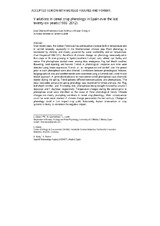Mostrar el registro sencillo del ítem
Variations in cereal crop phenology in Spain over the last twenty-six years (1986–2012)
| dc.contributor.author | Oteros, José | |
| dc.contributor.author | García-Mozo, H. | |
| dc.contributor.author | Botey, Roser | |
| dc.contributor.author | Mestre, Antonio | |
| dc.contributor.author | Galán, Carmen | |
| dc.date.accessioned | 2024-02-08T20:00:42Z | |
| dc.date.available | 2024-02-08T20:00:42Z | |
| dc.date.issued | 2015 | |
| dc.identifier.issn | 0165-0009 | |
| dc.identifier.uri | http://hdl.handle.net/10396/27330 | |
| dc.description.abstract | Over recent years, the Iberian Peninsula has witnessed an increase both in temperature and in rainfall intensity, especially in the Mediterranean climate area. Plant phenology is modulated by climate, and closely governed by water availability and air temperature. Over the period 1986–2012, the effects of climate change on phenology were analyzed in five crops at 26 sites growing in Spain (southern Europe): oats, wheat, rye, barley and maize. The phenophases studied were: sowing date, emergence, flag leaf sheath swollen, flowering, seed ripening and harvest. Trends in phenological response over time were detected using linear regression. Trends in air temperature and rainfall over the period prior to each phenophase were also charted. Correlations between phenological features, biogeographical area and weather trends were examined using a Generalized Lineal Mixed Model approach. A generalized advance in most winter-cereal phenophases was observed, mainly during the spring. Trend patterns differed between species and phenophases. The most noticeable advance in spring phenology was recorded for wheat and oats, the “Flag leaf sheath swollen” and “Flowering date” phenophases being brought forward by around 3 days/year and 1 day/year, respectively. Temperature changes during the period prior to phenophase onset were identified as the cause of these phenological trends. Climate changes are clearly prompting variations in cereal crop phenology; their consequences could be even more marked if climate change persists into the next century. Changes in phenology could in turn impact crop yield; fortunately, human intervention in crop systems is likely to minimize the negative impact. | es_ES |
| dc.format.mimetype | application/pdf | es_ES |
| dc.language.iso | eng | es_ES |
| dc.publisher | Springer | es_ES |
| dc.rights | https://creativecommons.org/licenses/by-nc-nd/4.0/ | es_ES |
| dc.source | Oteros, J., García-Mozo, H., Botey, R. et al. Variations in cereal crop phenology in Spain over the last twenty-six years (1986–2012). Climatic Change 130, 545–558 (2015). https://doi.org/10.1007/s10584-015-1363-9 | es_ES |
| dc.subject | Phenology | es_ES |
| dc.subject | Crop | es_ES |
| dc.subject | Cereal | es_ES |
| dc.subject | Generalize Linear Mixed Model | es_ES |
| dc.subject | Onset Date | es_ES |
| dc.subject | Sowing Date | es_ES |
| dc.subject | Rainfall Trend | es_ES |
| dc.subject | Phenological Event | es_ES |
| dc.title | Variations in cereal crop phenology in Spain over the last twenty-six years (1986–2012) | es_ES |
| dc.type | info:eu-repo/semantics/article | es_ES |
| dc.relation.publisherversion | http://dx.doi.org/10.1007/s10584-015-1363-9 | es_ES |
| dc.relation.projectID | Gobierno de España. CGL2011–24146 | es_ES |
| dc.rights.accessRights | info:eu-repo/semantics/openAccess | es_ES |

